Grade Levels
4-7
Subjects
Language Arts, Science, Social Studies, Health, Art, Media Literacy
Grade Levels
4-7
Subjects
Language Arts, Science, Social Studies, Health, Art, Media Literacy
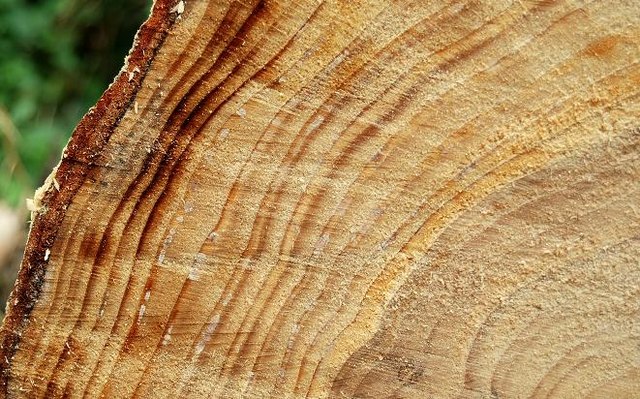
Tree rings from the Hillsborough forest, UK. Image Source
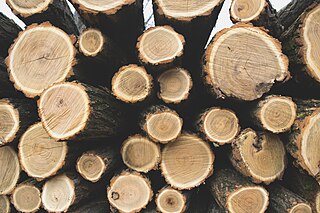
Stacked wood for lumber showing a variety of ring patterns. Image Source
Thanks for listening to our episode about dating trees, or dendochronology! This episode was filled with great music and questions from our host Katie Stone, and Kids Crew members to Dr. Peter M. Brown, founder of Rocky Mountain Tree-Ring Resarch.
We learned interesting information about ancient trees, stories of trees, and how trees can teach us about climate change, the history of a place, changes in the environment, life lessons and so much more! Learn more about what you heard in the show, by completing the activities below.
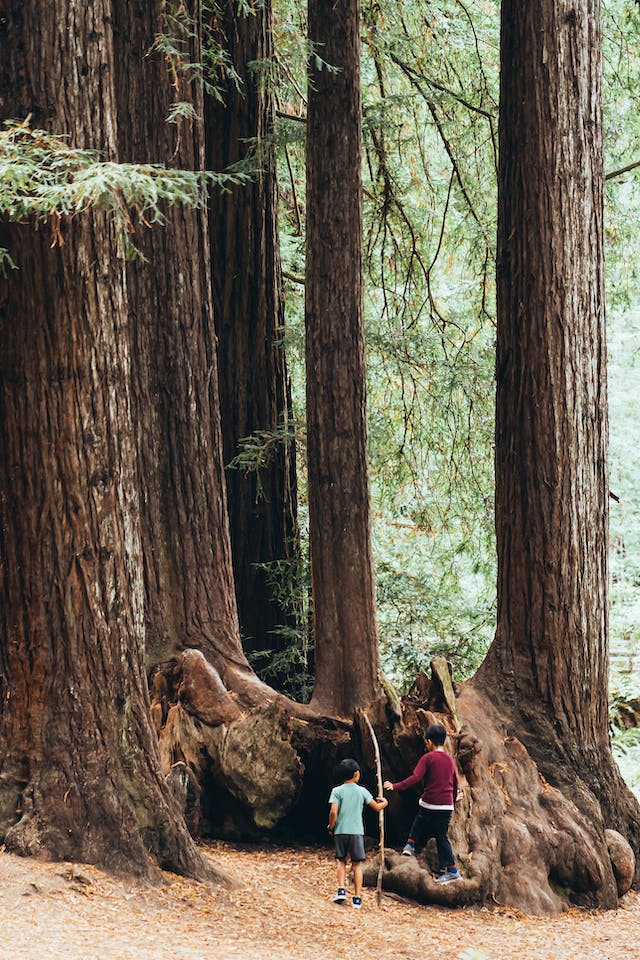
Children stand with giant Sequoias.
Image Source
Dendrocronology
The science of using techniques to understand the age, history, and climatic changes in the environment of a tree.
Increment Borer
A tool that allows for the removal of a core sample of a tree for further study, it can be done without harming the tree.
Vocabulary
Vocabulary words can be found throughout the page in bold.
Methuselah
Believed to be one of the oldest known living trees in the world, almost 5,000 years old. This tree is a bristlecone pine and is found in Eastern California.
Crossdating
A technique that matches patterns of rings of a single tree, along with those of other trees to gather information that helps to identify the exact year in which each ring was formed.
Petrified Wood
Wood from a tree that has been fossilized and preserved. When studied, it can tell scientests a lot about its life.
Dendrochronology
Dendrochronology is a field of science that studies tree rings. By studing tree rings, scientists learn about the age of a tree, the changes in climate and environment that it has experienced, and it’s history. That information allows us to learn even so much more about a place and the people that live there.
The name Dendrochronology comes from the greek words “dendron” meaning tree, “kronos”, meaning time, and “-logia”, meaning study of. It is closely related to Dendroclimitology, the study of climate through trees. Other related areas of science include archeology, the study of human activity, dendrology, the study of trees, botany the study of plants, and geology, the study of the earth.
Dendrochronology is conducted with the help of field scientists, tools, and computer programs that analyze data. One of the most important tools is the increment borer, which is basically a tree drill that can remove a sample of the core of the tree, without doing any permanant damage to it. The borer is twisted into the trunk of the tree until it’s halfway through. Then the extractor part is pushed into the hollow tube. By twisting it, the borer cuts out a long cylindrical core of wood from the tree. The core comes out with the extractor. You can count the stripes on the core sample. This process of drilling a deep hole does cause a small injury to the tree, which heals quickly. The tree will continue to live.
Dendrochronologists take good care to try not to harm trees that they study, but there are some instances where entire stumps can be analyzed, such as with the giant Discovery Tree, due to people cutting it down in the past. What is learned from this tree stump is used in efforts to conserve, or save and protect future trees.
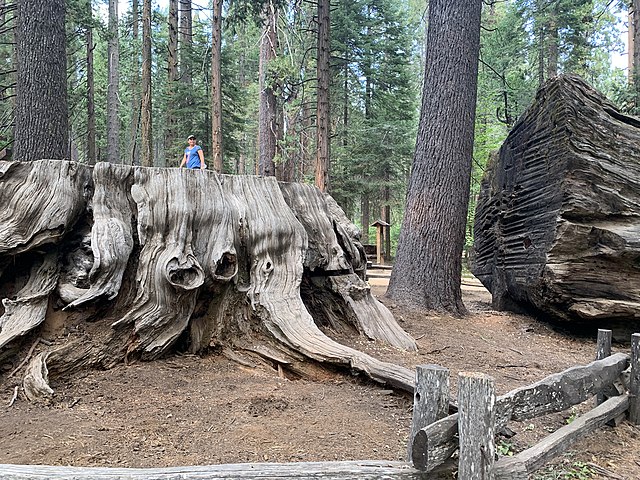
Last remaning stump of giant Sequoia, Discovery Tree. Image Source
Guiding Questions
Answer these questions as you read:
1. What is dendrochronology?
2. Describe a tool that is used to collect samples of a tree.
3. How do dendrochronologists protect trees?
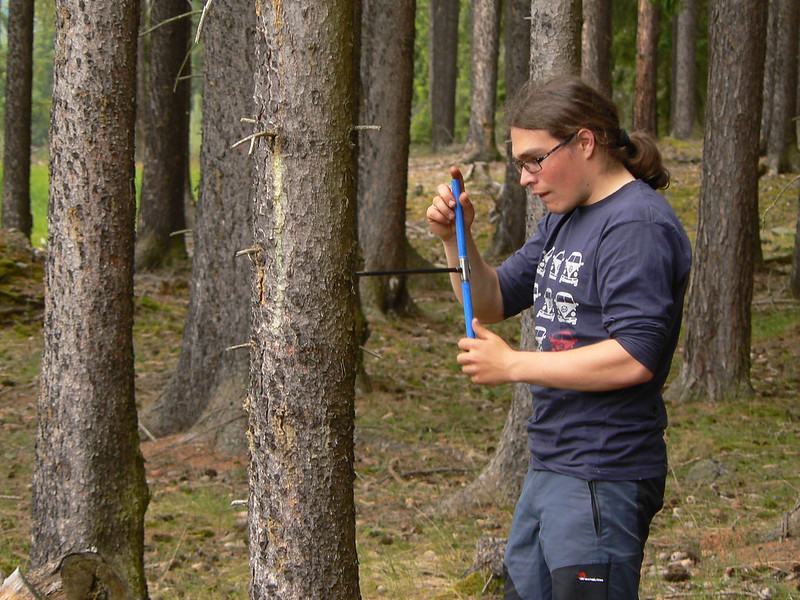
An increment borer is used to take a core sample. Image Source
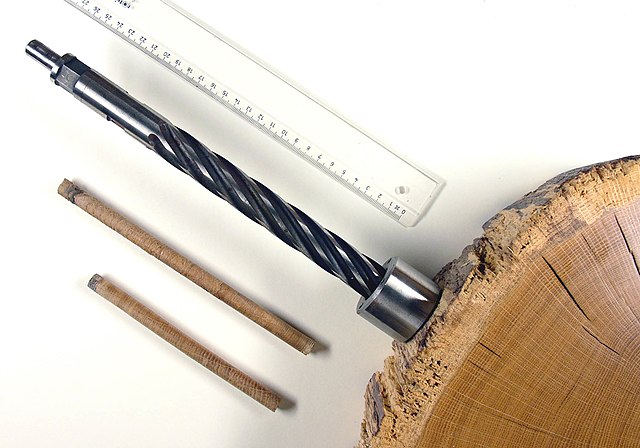
Tools allow scientists to carefully remove and study samples of the tree. Image Source
Trees and Climate Change
The research of scientists like Dr. Brown shows us that tree rings provide snapshots of earths past climates. The climate of an area controls the growth of its trees, and we can better understand the impacts of climate change by studying the cross sections and cores samples of tree rings.
Trees grow more in warm, wet years, so the ring will be wider. Likewise, tree rings are thinner in years when it is cold or dry. In very dry years, such as a drought, the tree might hardly grow at all. A forest fire can char the bark, leaving a darker scar on the ring. During the summer months of recent years, some trees in some places have been growing faster than normal, this is due to summers being hotter than usual.
Information like this helps people to understand the impact of climate change on the environment, predict future changes, and raise awareness about some of the climate challenges that we will face.
Dead wood and petrified wood, which has been fossilized, help build chronologies, or historical timelines about the past climate. Petrified wood can teach us a lot about the life of the tree it comes from and the changes in climate an area has faced. We can compare cell sizes in petrified wood from trees and see how fast they are growing in comparison with modern trees from the same area.
Trees Tell a Story
As we heard from Dr. Brown, trees keep record of events that occur throughout their lifetime. Their layers of growth are shown in the rings within their trunk. The details of the rings including the width, thickness, shape, color, and any scars or abnormalities all relate to specific events that impacted the tree. These are some of the things that trees can keep records of:
Climatic Factors
Precipitation, sunlight, soil composition, weather, temperature.
Natural Disasters
Floods, hurricanes, droughts, lightning strikes, earthquakes, fires.
Other Environmental Events
Insect damage, fungal diseases, human activity such as cutting down trees for wood or to clear land, and starting fires.
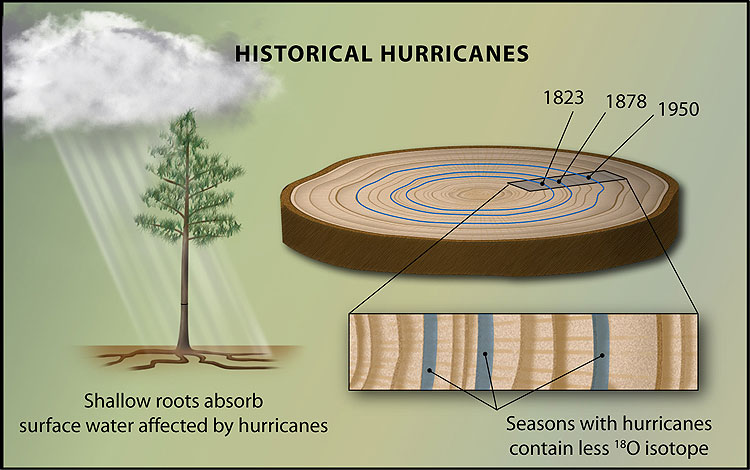
Natural disasters like hurricanes affect the growth of trees. Image Source
Activity: Tell the story of a tree
Tell the story of a tree! Follow along with this video to create a history of the life of a tree and things it experienced. Supplies needed are paper, pencil, crayons or markers, scissors, and glue or tape. Find templates to help you create your story here: Dating Trees Activities
Life Lessons from Trees
As we have learned by now, trees store information about their past and teach us about its history and environment, but trees like the ones we heard about in the show, can also teach us a lot about how to live our lives as humans. Trees like Methuselah, a Bristlecone Pine which is believed to be the oldest living tree alive, have experienced a lot of change as they been around for almost five thousand years. Similarly, Native Americans, or Indigenous Peoples, have maintained their cultures alive for thousands of years and continue to teach their children life lessons using trees as guides.
All trees are unique, just like people, and they allow us to appreciate the differences between us. Trees are also resilient, which means they survive through tough times just as people can too. Trees also live in harmony with other creatures, which means they co-exist in ways that benefit themselves and the creatures who use them for shelter, food, breeding, and more.
Reflection Questions:
1. When you think of trees, what positive words or ideas come to mind?
2. What do trees represent for you, your family, and your culture?
3. What are some songs, stories, books, or movies that you are familiar with related to trees?
4. What are ways that you think trees can teach people about life?
Activity: Look at the examples in the infographic, then research what kind of trees are in your area, and find out more about what makes them special and important. Then, create a poster that shares information about the tree you would like to highlight, and a lesson that people could learn from that tree. Hang up your poster at your school, in your local library, at a community center, or at another location where it is visible to others.
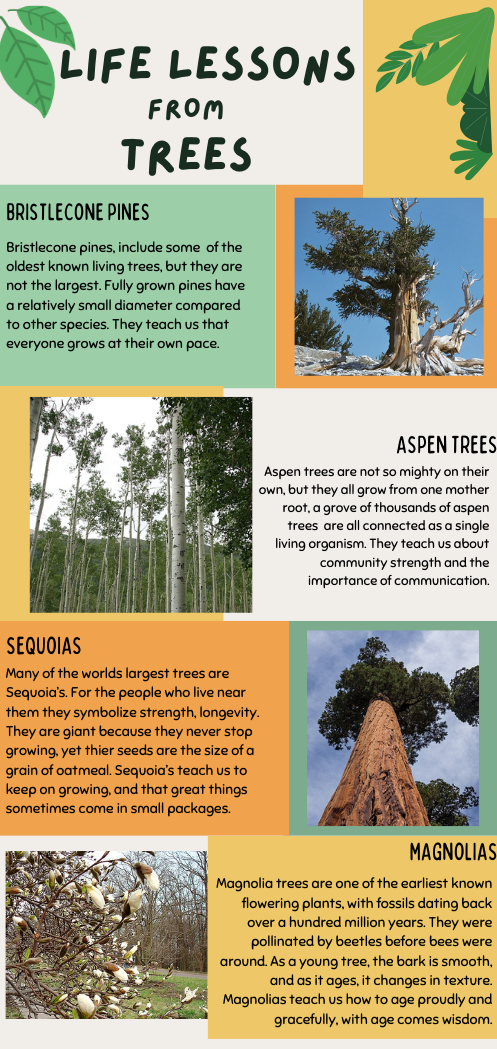
Infographic made with canva.
Trees, My Family, and Me
Trees tell stories and hold knowledge and wisdom within their rings. A trees life represents the passing of time from generation to generation. Perhaps this is why many people represent the lineage of their family through a “family” tree. Find the handout in the Dating Trees Activities to create your own family tree.
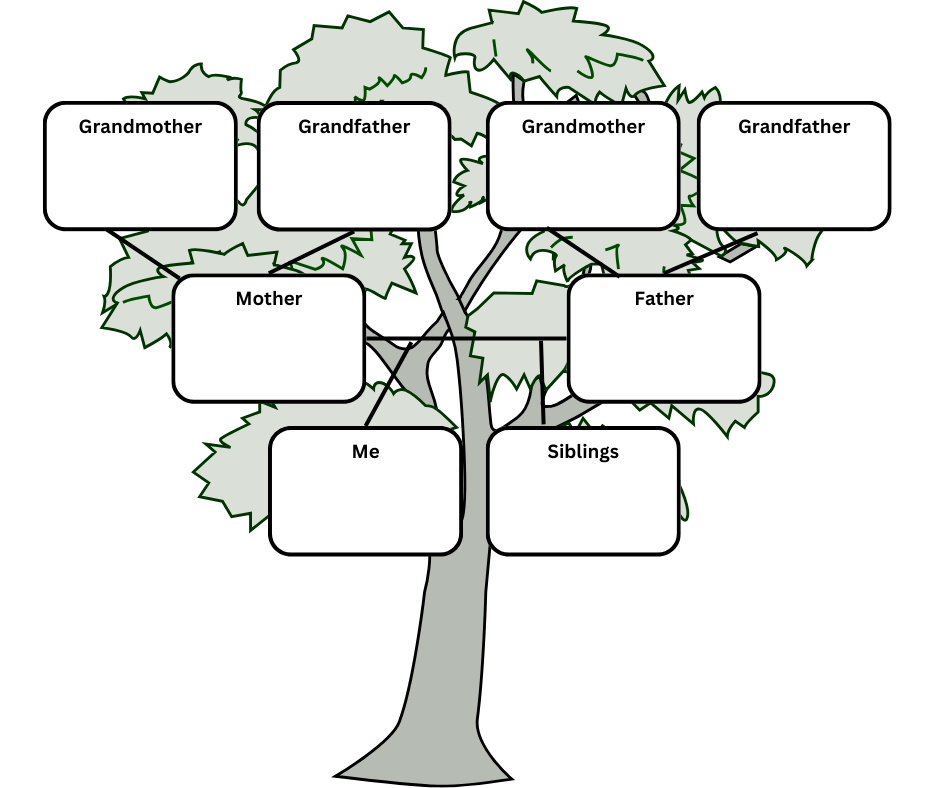
Infographic made with canva.
Activity
Take your family on an adventure to discover and learn more about trees in your region. Check out this website to learn about what to bring on your adventure, activities to do, and search a map of a forest near you.
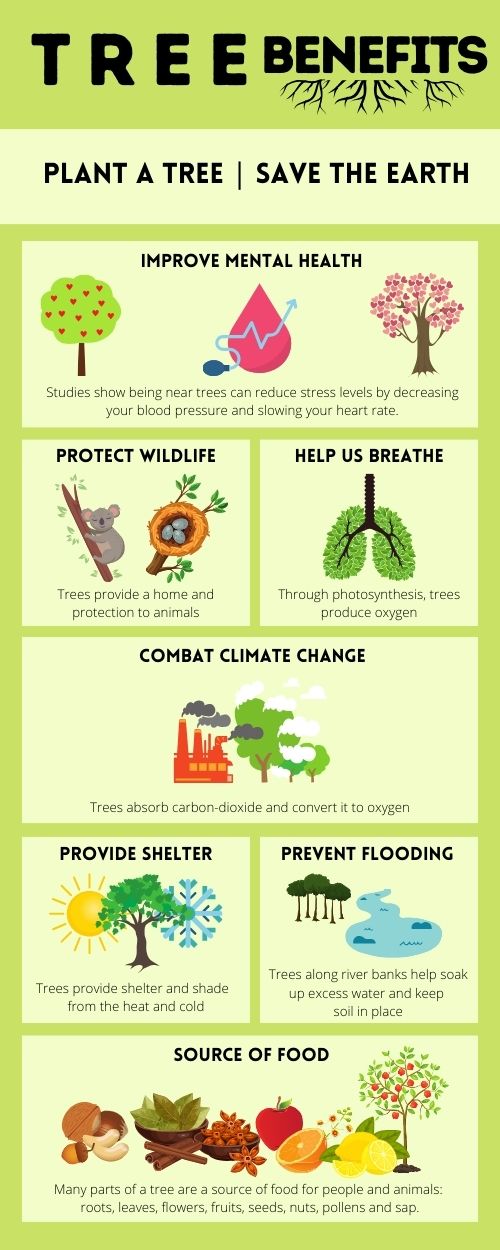
Infographic from canva.
Trees Witness the History of People and Places
Dendrochronology is a way of understanding what happened throughout the growth of a tree to reveal the natural history of the tree and its environment. This is done through crossdating which is analyzing several tree ring samples (increment cores). The repeated patterns of wide and narrow rings of one tree are matched to samples of other trees in the same area, and then those patterns are matched to trees in the same region, all of which would have been responding to the same climate factors. Then, by working backward from the current year, the dendrochronologist can determine the exact year in which each growth ring was formed.
For example, if we will attempt to know the date that an ancient Pueblo was built (C on the diagram), we first extract increment cores from living trees (A). We develop a living tree chronology for the nearby area. Then, the living tree chronology is extended by obtaining cores from dead standing trees nearby (B). Finally, cores taken from wooden beams inside the Pueblo ruins are cross-dated with tree ring patterns from the other two sites. So, we can count the total number of rings backwards in time to determine the age of the wood in the Pueblo. Did you know, our guest Dr. Brown was inspired by this type of work when he was a young boy. What is it that inspires you?
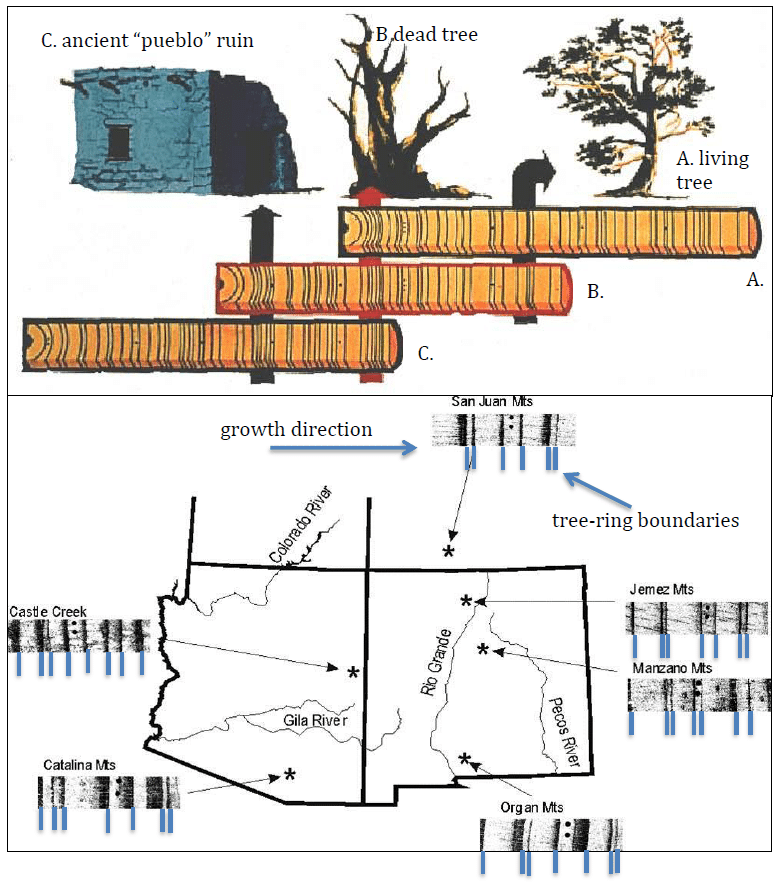
Image Source
Media Journal: Dating Trees
After watching one or both of the videos, use the guiding questions to reflect on what you learned. Share your information with another person.
What did I already know about this topic?
What did I learn from the video?
What new questions or wonders do I have?
More Activities and Resources
Learn about the life experiences and see the timeline of a tree.
Interactive tree ring simulation activity.
Check out “From seeds to giants” lesson plan about dendrochronology, with accompanying resources.
Browse the worlds largest public archive of tree ring data.
Discover more tree ring educational resources.
Complete some fun and easy tree and forest activities.
Learn how to sprout and plant a tree, with a step by step plan, while also learning which species to plant and where. Then, review this planting and care guide.


